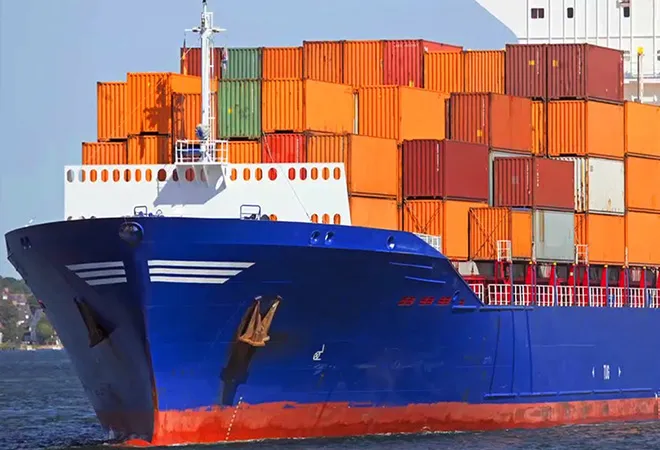
Acknowledging wealth creation for all as a means to build a vibrant economy, the government of India, through various programmes, has appealed to Indian and foreign corporates to invest and grow their businesses in India. Against this backdrop, it would be important to draw attention to the case of Maritime Transport Sector, whose scope in terms of attracting investments, creating jobs, and most importantly, being a tool to save huge foreign exchange outflows, seems to have missed the attention of both – the policymakers and economists. The sector has the potential to grow with just a few bits of fundamental and structural changes.
The biggest opportunity or what investments in this sector can bring, is the saving of USD 50 billion, which is the approximate net freight outgo being currently paid by Indian trade/India every year to foreign shipping companies. In a particularly bad year, this has been the quantum of India’s current account deficit. The freight outgo has been calculated on the basis UNCTAD Review of Maritime Transport 2017, that had measured the transport and insurance costs covering the time period from 2006-2016. This study pegs the world’s average cost of transport and insurance being 15 percent of the value of imports/total trade. At a conservative 7.5 percent of India’s EXIM trade, the freight bill of India works out to USD 62.88 billion FY19. Other logistics costs and insurance costs would add up to another 7.5 percent.
This large forex outflow is because India’s national fleet carries only 9.7 percent of India’s EXIM trade and around 59 percent of domestic coastal cargo as in FY19. All of the balance is carried by foreign ships, who simply walk away with the freight, tax free. This situation can be reversed by simply bringing all these EXIM cargoes on to ships owned by Indian companies.
It would be pertinent in this context to mention the case of Greek shipping. In the global financial crises of 2008 and in the subsequent years, Greek shipping suffered like the others did. But in the 12 years hence, it has rebuilt its position with the largest fleet in the world using Asia and India centric trades. Yet, Indian shipping sector hasn’t been able to increase its market share using India’s own EXIM cargoes. The moot point here is how does the Indian government and the Indian shipping industry pull this off.
The lack of anti-dumping measures against foreign services imports even if they were being dumped in India at rates cheaper than its input costs in the country is a big impediment for the growth of the India’s services sector. Indian law does not impose “tariffs” on services. At best, it asks foreign service providers to set shop in India. Sadly, this caveat does not apply to maritime services.
Maritime transport or shipping is predominantly a services activity. The only “goods” component that arises in its context is the import of ships by Indian shipping companies for providing maritime transport service. Further, the import of shipping services is cheaper compared to procuring from or providing these services from a legitimate Indian shipping company who pays all taxes in India.
Given the international nature of the shipping business, the foreign trade policy as well as the domestic shipping and taxation policy of India needs to be in sync. In terms of robust policy for the Indian shipping sector, it would entail straddling both the international operating environment and domestic realities, and ensuring that domestic Indian flag shipping companies are taxed only to the extent that they continue to remain globally competitive. This is a task that Indian policymakers don’t seem to have fully applied their minds to.
To give the Indian government its due, it has made intermittent and piecemeal efforts to bring about the growth of Indian shipping. They have also thrown in one-off policy incentives. But these efforts have been rendered ineffective because the basic input cost structure of the Indian shipping industry is not conducive for its growth. It falters on every competitive parameter when compared with 1) other foreign shipping companies operating on the coast as well as on EXIM trades 2) other modes of domestic transportation namely; rail and road.
On the other side are those foreign companies who would rather continue to enjoy tax-free revenue from Indian charterers for services provided. Such companies would not want India to make any progressive policies, which would require shipping services to be provided through an Indian company. Vested interests tend to mislead the policy framers into missing the woods for the trees. The lobby of foreign shipowners in India, in a sustained manner, continues to delude Indian policymakers into believing that freight rates would fall in India and Indian trade would benefit, if foreign-owned shipping companies were continued to be given unfettered access to Indian cargo and the Indian coast. As a result, the Indian government loses out on the tax revenues from foreign shipping companies and the freight bill of Indian trade continues to increase. The current struggles of the Special Secretary (Logistics) and the Member (Customs) along with other domestic industry bodies to try and ensure fair and transparent Terminal Handling Charges (THC) on Indian imports and the steadfast stubbornness of the foreign container lines opposing it, is a standing example. This has also been the experience of several world economies as can be evidenced by the legal action initiated by them against the practices of global container companies.
Often, bogies with different names and nomenclatures are produced in order to cease the beneficial drive towards a greater Indian shipping industry. One favourite bogey is that of “insufficient Indian ships”. Another “the need to ensure transhipment from foreign ports is weaned back into India”. This is understandable given that the “pie” that they are protecting is worth USD 50 billion dollars a year or more, and that too, tax free. What is not understood is how intelligent policymakers are unable to see through this smokescreen.
There is a need for the policymakers to therefore see what India, the economy, its seafarers and the exchequer are losing. The key issue is to make investments in Indian shipping services attractive. The “India costs” which are absent when not providing services from a non-Indian company need to be addressed. These uneven and illogical burdens, which make the domestic industry uncompetitive, needs to be ironed out. A simple back of the envelope working will show that providing a shipping service from an Indian company is at least 26 percent costlier than providing that same service in India through a foreign company.
Imagine what would happen if you were able to procure the services of a lawyer from the UK or Singapore, in Indian arbitration, at costs lesser than those from an Indian lawyer or law firm. Similarly, in case of accountancy services, taxation services, etc. the list can go on. Every country ensures that goods and services should be, to the extent possible, provided through its local companies – regardless of the ownership of these companies.
Port services in India are provided through Indian companies which, except for one, are completely owned by foreign interests. Such foreign interests invest in India, in Indian companies, employ Indians, earn money in India, employ those earnings to grow in India and take some away as dividend to their home country, and rightly so. The basic canon of economic policy is the need to ensure the ploughing of income into the economy and spurring greater growth back in the country where the opportunity arose. Yet, the same ministry does not seem to be able to follow this very logic when it comes to providing shipping services.
Suffice to say that lack of attention to this very basic issue of corralling the investment into shipping services using the USD 50 billion as the proverbial pot of gold is the important issue. Having in place policies that would encourage foreign companies to invest in companies, who are into the business of providing shipping services in India. In order to do this, a first step would be to try and link market access to investment – come and invest in India if you want access to its 700 MT volume of EXIM trade.
The views expressed above belong to the author(s). ORF research and analyses now available on Telegram! Click here to access our curated content — blogs, longforms and interviews.




 PREV
PREV


